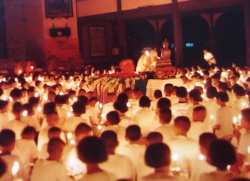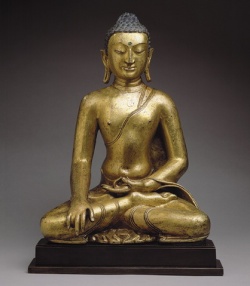Designation and Ontological Commitment in Sellars and Prasangika Madhyamika
Eric J. Loomis, University of South Alabama, USA
Abstract
The Prasangika Madhyamika system of Buddhist philosophy claims that the basis upon which we designate an object is never the object designated, even in cases in which the designation is truly made. This claim leads to their doctrine of “two truths”: ultimate truth and conventional truth. Both the claim and the doctrine have interesting similarities to views advanced by Wilfrid Sellars, particularly his distinction between the scientific and the manifest image. I explore some of these.
Table of contents
References
The Prasangika Madhyamika system of Buddhist philosophy has a striking account of the ontological commitments involved in naming and designation. The controlling claim in their account is that the basis for the designation of an object is never the object designated, even in cases in which the designation is truly made (cf. Lamrimpa 1999, 39; Klein 1994, 140). I’ll call this the “designation thesis” or DT. The Prasangika hold the DT to provide partial support for the core Buddhist contention that all phenomena are empty of self-nature, that is, that they lack establishment by way of their own entities (Candrakirti, 1980). The DT requires the Prasangika to draw a distinction between two domains of truth: conventional truth and ultimate truth. This distinction has proven difficult to expound. I hope to illuminate it, and the DT, by way of a comparison with Wilfrid Sellars’ distinction between the “manifest image” and the “scientific image”. I will use Sellars’ distinction as an entry point into the Prasangika’s DT and their doctrine of two truths.
Sellars distinguished the manifest and scientific images to mark a difference “between that conception which limits itself to what correlational techniques can tell us about perceptible and introspectible events and that which postulates imperceptible objects and events for the purpose of explaining correlations between perceptibles.” (Sellars 1991, 19) The scientific image is the scientifically informed conception of unobservable events that explain events that are directly perceptible through correlation with them. The entities of the manifest image are those of ordinary experience: pens, beliefs, pains, persons. It is these “in terms of which man first became aware of himself as man-in-the-world” (1991, 6).
Sellars presented the scientific image as a regulative ideal; a philosophical vision of an ultimately “completed” and unified scientific explanation (1991, 5). Whether such a vision is viable is not important here, for even in its current form, science tells us that many of the entities that comprise the manifest image, such as thoughts, or the pink of a pink cup, do not exist in the mode that the manifest image imagines. The thought, which in the manifest image has a qualitative character of an inner state analogous to speech, is imaged in a way nothing like the neurophysiological process that contemporary scientific image says it is. Similarly, the pink of the pink cup, which appears in the manifest image as a solid property possessed by an external object, does not exist in the same way in the scientific image, which posits instead a “gappy” system of discrete particles (1991, 34-5).
It is noteworthy that Sellars did not regard the displacement of the manifest image to be something that should lead to its rejection. To the contrary, not only is there no guarantee that science could ever reach the completed state posited in the scientific image, such a state, even if reached, would not reduce or eliminate many of the entities of the manifest image (1991, 36-7). One reason Sellars gives for this is the possibility that normative phenomena, among which Sellars counts human beings with their rights and duties, might never be reducible to the descriptive claims of the scientific image (ibid, 39).
The manifest image is thus not fully eliminable in favor of the scientific image, yet it is at odds with the scientific image at important points. Sellars clearly recognized the tension here. He proposed resolving it, in part, by a rational reconstruction of the manifest image in purely nominalist terms, thereby allowing for a greater “fusion” of the two images by removing the troublesome non-nominalistic uses of type-expressions such as color words. Yet even the hypothetical completion of such a project would not fully resolve the tension, as Sellars’ own example of normative elements in the manifest image exposes. Sellars thus offered us a second proposal for reconciling the two images: the hope that future science might reveal “a non-particulate foundation of the particulate [current scientific) image” which would make a fusion of the two images possible (1991, 37).
As these hopeful suggestions reveal, Sellars did not fully resolve the relation between the two images. Nonetheless, I think he did point out a real phenomenon. For it is the case that when we analyze a cup, say, we don’t find the entity of a cup among the analysans. What does appear among the analysans, in a scientific analysis, for example, is something like a collection of particles, states, and configurations, none of which are the cup itself, as a distinct entity. What we designate a cup seems to disappear upon analysis.
This feature, the unfindability upon analysis of a designated entity among the analysans, is one of the reasons the Prasangika introduce in support of DT. Their reasoning is straightforward. We call a certain phenomenon a cup. We do so for reasons: a certain visual or tactile appearance, perhaps, or an observation of something performing a certain function. These reasons are the “bases of designation”. In the case of empirical objects, they are typically perceptions. When we examine a basis of designation for a term, such as “cup”, we fail to find the designated object itself. But what exactly do we fail to find? The cup, as the expected, fully characterized entity. The cup as fully characterized occupies three dimensions of space and exhibits temporal continuity. It has sides, as well as past and future moments, which are not all apparent to someone making the designation. The fully characterized cup also has functional, causal, and dispositional properties, such as holding small quantities of liquid, or exhibiting resistance to touch, which are also not all apparent at a given time. Among the dispositional properties, some can be characterized only counterfactually (the cup would have been a receptacle for juice, had we poured some in it, e.g.) and so are necessarily not apparent. In sum, what is designated, cup, is not findable among the bases for designating a given locus “cup”. We certainly find reasons for calling something a cup. But upon analysis we find that these reasons, the bases of designation, fall short of the object designated, the fully characterized cup.
Among empirical objects, then, the Prasangika distinguish between:
The basis of designation of a thing, which is our ground(s) or reason(s) for applying an expression, such as “cup”, to a given locus.
The designator, which is a conventional label or sign with an agreed-upon use, like “cup”.
The designated object, which is what I have called the “fully characterized entity” that we hypothesize, or impute upon a basis (cf. Lamrimpa 1999, 36; Klein 1994, 131f).
Bases of designation: such as a particular cup-like appearance, the observed function of holding small quantities of liquid, or a particular collocation of particles, are not the designated object cup. For instance, the observed function of holding small quantities of liquid, while part of a sufficient reason for designating something “cup”, is not identical to the designated object cup (the function doesn’t exhibit resistance to touch, e.g.). Were the designated object among the bases of designation, we would find it there upon analysis. But we do not. Call this argument for DT the “unfindability argument”.
The Prasangika adduce a second argument for DT, which I’ll call the “fallibility argument”. Suppose for a reductio that a designated object existed among its bases of designation, so that, say, cup was among the bases of the designated object cup. Then the basis, the ground or reasons for applying the expression “cup”, would entail that “cup” was correctly applied given that basis. But this result is contradicted by the observation that our reasons for calling something a cup are never entailing reasons.1 Our reasons for calling something a cup are various cup appearances, and as such are fallible. Take any reasons for calling a given entity a cup, such as some observations. There is no logical contradiction involved in supposing that those reasons are defective (the product of a clever deception, say). If the designated object were among the bases of the designation, there would be a contradiction in supposing the reasons could be defective. But there isn’t one.
I think that the unfindability and fallibility arguments are sufficient to motivate DT. But if DT is accepted, when can we say that a given designator is truly applied? Here the Prasangika mark a distinction akin to Sellars’. They distinguish between the conventional truth that a given thing is correctly, truly called a cup, and the ultimate truth that the entity of a cup is unfindable among its bases of designation.
A conventional truth, for the Prasangika, must satisfy three conditions:
It must be commonly accepted with respect to ordinary cognition.
It must not be undermined by another valid conventional cognition.
It must not be undermined by reasoning examining ultimate truth (cf. Lamrimpa 1999, 88f; Klein 1994, 45f.).
A cognition (jnana) is an awareness that may include propositional content. A cognition is ordinary iff it is established as true according to the conventions of use in a given community which govern the relevant designator (Lamrimpa 1999, 92). In English-speaking communities, the designator “cup” is governed by certain conventions licensing its application given a certain basis. One such convention may be that the object designated “cup” be intended for use in holding and drinking small quantities of liquid. The first condition is thus a positive one: it postulates grounds that, if met, defeasibly license the claim that a judgment is conventionally true.
The second and third conditions specify two types of defeating conditions. They rest on a distinction between conventional and ultimate cognitions, which stems from the aim of the inquiry generating the cognition (Klein 1994, 46). A conventional cognition is the result of an inquiry aimed at establishing that a particular entity exists, or that it has such-and-such functional properties. An ultimate cognition is the result of an inquiry into whether phenomena exist in the mode that they appear to when established conventionally. Searching for a cup, or seeing how much water a cup holds, are examples of inquiries generating conventional cognitions. But a cup may appear to be its own basis of designation. If it does, then searching for the cup among its bases of designation is an inquiry generating ultimate cognitions. Its goal is to see if the cup exists in the mode that it appears to.
If, having judged that something is a cup, we find that it is a cup illusion (a hologram, say) then the condition (2) of conventional truth is not met. In such a case we are in the presence of a defeater (like a valid conventional cognition of a hologram generator), which undermines the grounds, deriving from condition (1), for the correct application of “cup”.
Condition (3) blocks admitting entities that are their own basis of designation as truly conventionally existent merely because they satisfy the first two conditions. If, upon analysis, entities are not findable among their bases of designation, then the mere fact that people ordinarily believe that they are so findable, and don’t find further conventional cognitions that undermine this belief, ought not be a sufficient reason to allow it as conventionally true that they are findable. Condition (3) thus insures that conventional truths, like ultimate truths, typically require grounds that go beyond what a given community might believe to be the case.2
Prasangikas thus do not deny that a statement like “this is a cup”, uttered in the presence of what a qualified speaker would call a cup, is true. It is true, provided that the defeating conditions don’t obtain. However, the content of the true statement “this is a cup” is exhausted by the statement “This is called a ‘cup’” (Lamrimpa 1999, 43). This latter statement acknowledges that the (undefeated) bases of designation for “cup” obtain, and so “cup” is correctly applied, while avoiding the tempting but faulty inference that cup exists as the basis of the designation “cup”.
When Sellars asked whether objects of the everyday manifest image exist in they way they appear, he was, from the Prasangika perspective, engaged in an analysis aimed at ultimate truth. Like them, he returns a negative verdict: phenomena do not exist as they appear, at least in the manifest image. Yet as I have suggested, Sellars had difficulty reconciling this result with his conviction that many of the judgments made about the entities of the manifest image are in some way correct. Here, I think the Prasangika offer an improvement. On their account judgments made about ordinary phenomena – conventional cognitions – can be quite straightforwardly true. They are true iff the undefeated conditions for the application of the relevant concepts are met – full stop. There is no need to aim at a further “fusion”, since there is no conflict between conventional and ultimate truth.
There is a deep difference between Sellars and the Prasangika, however. Sellars is an avowed scientific realist. For him, whatever ultimate truth there is will be cashed out in terms of completed science. The Prasangika would disagree, but not because they deny that scientific results may yield truth. To the contrary, every time that a scientific explanation accounts for some object in terms of factors other than the designated object, that explanation helps to establish DT. But the Prasangika will deny that scientific posits exist as their own bases of designation. They will deny, for example, that the basis for the designation “muon” is the designated object muon. They would point out that competent members of the community of English speakers designate something a “muon” based upon factors such as observed charge and mass characteristics, a half-life of a certain duration, decay products, and so on. Yet these phenomena, while they may well constitute the basis of designation for “muon”, are clearly not the designated object muon. This latter is no more identical to an observed 2 mirosecond half-life, say, than the designated object cup is identical to the observed function of holding small quantities of liquid. Emptiness for the Prasangika -- the fact that phenomena are not established by way of their own entities -- knows no limits.
References
Candrakirti 1980 Lucid Exposition of the Middle Way, Mervyn Sprung (trans.), Boulder: Great Eastern.
Lamrimpa, Gen 1999 Realizing Emptiness. B. Allan Wallace (trans.) Ithaca: Snow Lion.
Klein, Anne 1994 Path to the Middle: Oral Madhyamika Philosophy in Tibet. Albany: SUNY Press.
Sellars, Wilfrid 1991 “Philosophy and the Scientific Image of Man”, in: Science, Perception and Reality. Atascadero California: Ridgeview Publishers, 1-40.
Notes
1.
Note that “This is a cup” is not a reason to hold that “This is a cup” is true, on pain of question-begging.
↵
2.
This requirement is satisfied for most conventional cognitions simply by the fact that a conventional truth requires the presence of a basis of designation, and whether this basis is present is normally not itself merely a matter of convention or belief.
↵
Eric J. Loomis. Date: XML TEI markup by WAB (Rune J. Falch, Heinz W. Krüger, Alois Pichler, Deirdre C.P. Smith) 2011-13. Last change 18.12.2013.
This page is made available under the Creative Commons General Public License "Attribution, Non-Commercial, Share-Alike", version 3.0 (CCPL BY-NC-SA)






